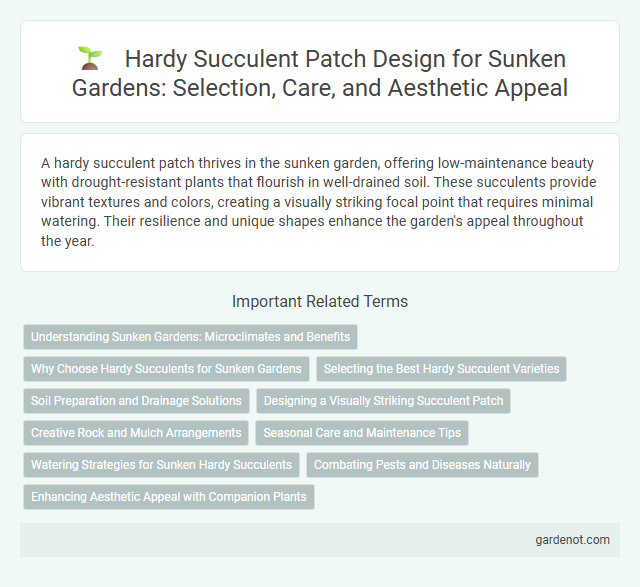A hardy succulent patch thrives in the sunken garden, offering low-maintenance beauty with drought-resistant plants that flourish in well-drained soil. These succulents provide vibrant textures and colors, creating a visually striking focal point that requires minimal watering. Their resilience and unique shapes enhance the garden's appeal throughout the year.
Understanding Sunken Gardens: Microclimates and Benefits
The Hardy Succulent Patch in sunken gardens thrives due to unique microclimates created by lowered ground levels that retain heat and moisture, providing an ideal environment for succulents requiring minimal water. These microclimates protect hardy succulent species from harsh winds and temperature fluctuations, enhancing their growth and resilience. Sunken gardens optimize natural insulation, promoting biodiversity while conserving water efficiently in succulent cultivation.
Why Choose Hardy Succulents for Sunken Gardens
Hardy succulents thrive in sunken gardens due to their exceptional drought tolerance and ability to withstand temperature fluctuations, ensuring low maintenance and year-round greenery. Their robust root systems prevent soil erosion, a common challenge in sunken landscapes. Selecting hardy succulents enhances aesthetic appeal while promoting sustainable growth in diverse microclimates typical of sunken garden environments.
Selecting the Best Hardy Succulent Varieties
Selecting the best hardy succulent varieties for a sunken garden involves prioritizing species such as Sempervivum, Sedum, and Agave due to their exceptional drought tolerance and resilience to temperature fluctuations. These succulents thrive in well-drained soil and partial to full sun exposure, ensuring vibrant growth and minimal maintenance. Incorporating diverse textures and colors from these hardy varieties enhances the aesthetic appeal and sustainability of the succulent patch.
Soil Preparation and Drainage Solutions
The Hardy succulent patch in the Sunken Garden thrives on well-prepared soil with excellent drainage to prevent root rot and promote healthy growth. Incorporating coarse sand, perlite, and organic compost enhances soil aeration and moisture retention while ensuring excess water drains efficiently. Raised beds or gravel layers beneath the soil further improve drainage, creating an ideal environment for succulents to flourish.
Designing a Visually Striking Succulent Patch
Designing a visually striking succulent patch in the Sunken Garden involves selecting hardy varieties like echeveria, sempervivum, and sedum that thrive in low-water, well-drained conditions. Arrange these succulents in layers of contrasting colors and textures to enhance visual interest and create a natural flow across the patch. Incorporate decorative rocks, gravel, and minimalist edging to emphasize the unique shapes and vibrant hues of the succulent collection, ensuring year-round appeal and low maintenance.
Creative Rock and Mulch Arrangements
The Hardy succulent patch in the Sunken Garden features meticulously designed creative rock and mulch arrangements that enhance drainage and highlight the unique textures of drought-tolerant plants. Strategic placement of weathered stones and finely shredded organic mulch creates a naturalistic yet structured environment, promoting healthy growth and weed suppression. These arrangements not only elevate visual appeal but also optimize water retention and soil aeration for the succulents' resilience.
Seasonal Care and Maintenance Tips
Hardy succulent patches in the Sunken Garden require careful seasonal care to thrive, including reduced watering during winter dormancy and increased drainage to prevent root rot. In spring and summer, succulents benefit from regular pruning to remove dead leaves and promote airflow, reducing pest infestations. Applying a balanced, low-nitrogen fertilizer in early growing season supports robust growth without encouraging excessive foliage.
Watering Strategies for Sunken Hardy Succulents
Sunken garden hardy succulents thrive with carefully managed watering strategies that prevent waterlogging while maintaining moisture. Deep, infrequent watering encourages strong root development, essential for drought tolerance in succulent species such as Agave, Aloe, and Sedum. Monitoring soil moisture levels and allowing the soil to dry out between waterings minimizes the risk of root rot and enhances plant health in sunken garden patches.
Combating Pests and Diseases Naturally
Hardy succulent patches in sunken gardens benefit from natural pest control methods such as introducing beneficial insects like ladybugs and using neem oil sprays to combat common pests and fungal diseases. Maintaining proper drainage and avoiding overwatering minimizes the risk of root rot and fungal infections in these drought-tolerant plants. Companion planting with herbs like rosemary and thyme also repels aphids and mealybugs, promoting a healthy succulent environment.
Enhancing Aesthetic Appeal with Companion Plants
Hardy succulent patches bring a unique texture and resilience to the sunken garden's landscape, thriving in well-drained soil with minimal maintenance. Integrating companion plants such as ornamental grasses, lavender, and sedums enhances the visual appeal by providing contrasting heights, colors, and seasonal interest. These combinations not only improve soil health through complementary root systems but also attract pollinators, promoting a balanced and vibrant ecosystem.
Hardy succulent patch Infographic

 gardenot.com
gardenot.com